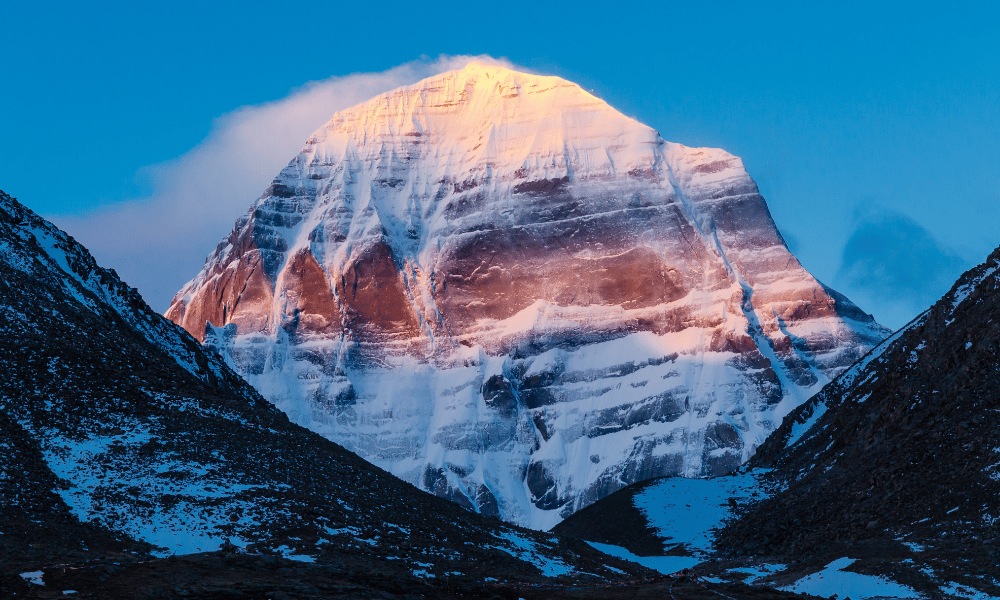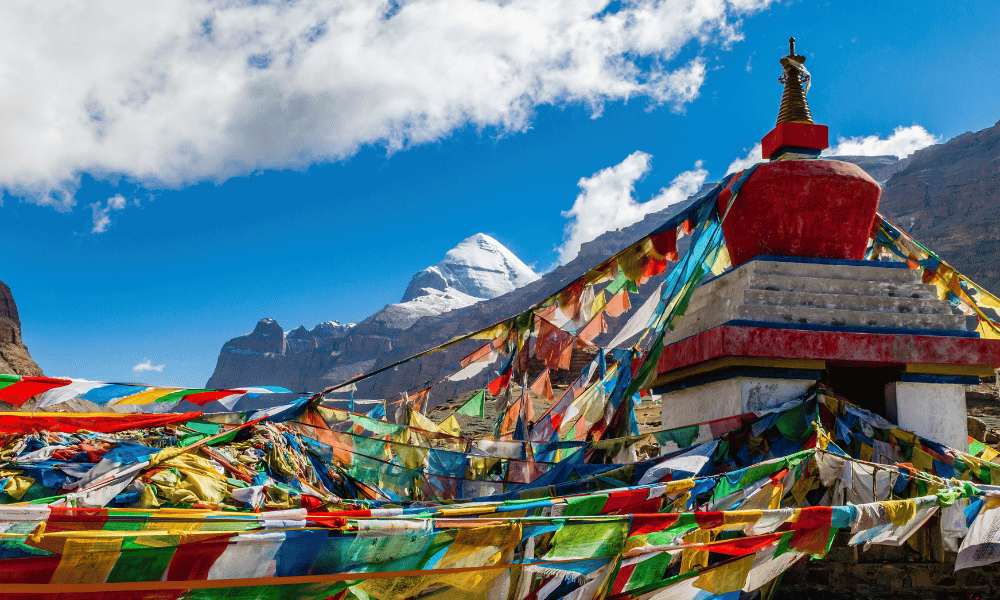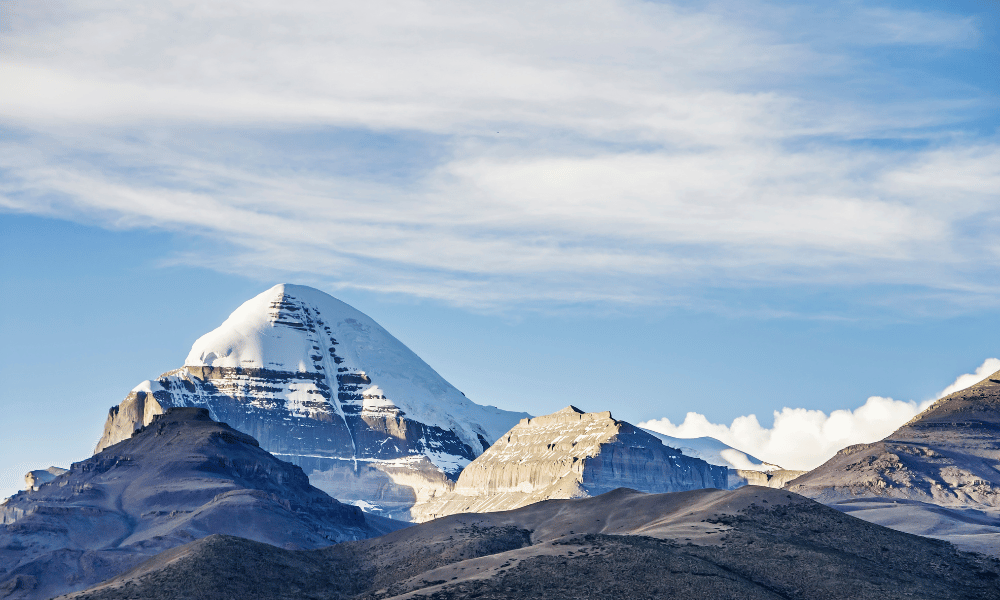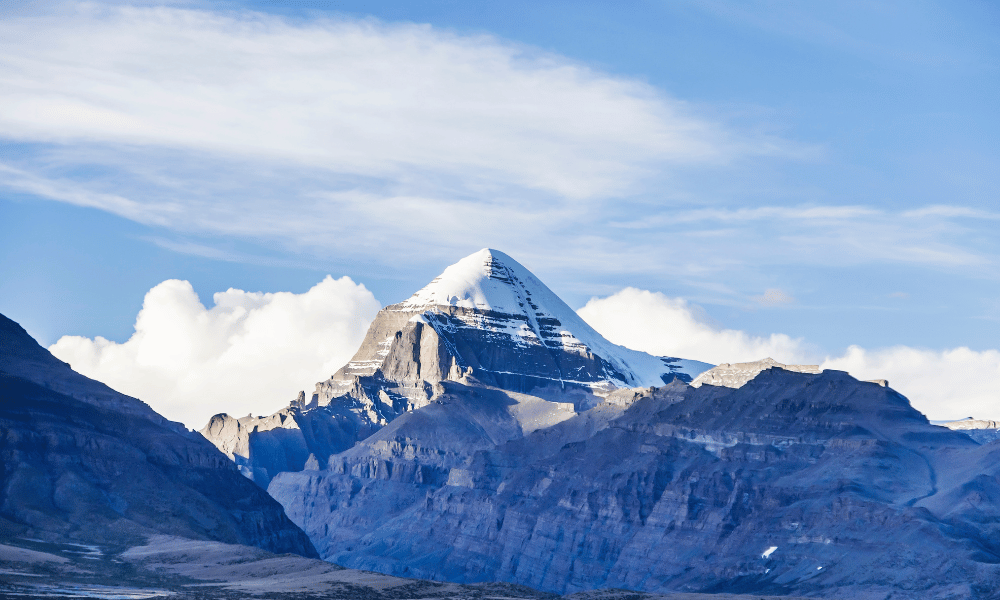Kailash Mansarovar Yatra, which starts from Malaysia and goes through Nepal on a beautiful and culturally rich route, is a renowned journey that draws both religious people and adventurers. This spiritual trip is a deep journey of personal and spiritual growth that lets people immerse themselves in the beautiful scenery and lively cultures of Nepal and Tibet. Getting ready for this journey requires careful planning, like getting the right visas and permits, getting in shape physically and mentally, and packing the right things for the high-altitude walk. As pilgrims travel from the busy streets of Kathmandu to the peaceful Tibetan plateau, they not only see the amazing beauty of Mount Kailash and Lake Mansarovar, but they also feel a deeper connection with the divine, which is enhanced by the rich cultural interactions and the majestic natural surroundings. It's a life-changing trip that offers not only beautiful sights but also a deeper spiritual connection. Those who go on it will have a once-in-a-lifetime experience.
FOR YOUR TRIP RESERVATION EMAIL US : KAILASH@HOLIDAYSTONEPAL.COM
The Kailash Mansarovar Yatra is one of the most significant and respected pilgrimages in Hinduism, Buddhism, Jainism, and the Bon religion. As worshippers travel through some of the world's most beautiful and rugged terrains, the pilgrimage incorporates spirituality, culture, and a strong feeling of personal achievement.
Spiritual Relevance:
-
Hinduism: In Hindu belief, Mount Kailash is the abode of Lord Shiva, the god of destruction and regeneration. Pilgrims believe that circling the mountain can cleanse sins and bring divine blessings.
-
Buddhism: For Buddhists, Kailash is associated with Demchok, a deity of Vajrayana Buddhism. It is seen as a symbol of the ultimate goal of enlightenment.
-
Jainism: In Jainism, the mountain is associated with the first Tirthankara, Rishabhadeva. It is believed to be the place where he attained liberation or Moksha.
-
Bon Religion: Followers of the Bon religion, an ancient Tibetan religion, also regard Kailash highly. It is considered the seat of all spiritual power.
Cultural Significance:
-
A journey to Kailash Mansarovar offers an opportunity to immerse oneself in the diverse cultures and traditions that have revered the mountain and lake for centuries.
-
The pilgrimage is also a site for several festivals and rituals, offering a deep dive into the spiritual traditions and practices of the region.
Personal Growth and Enlightenment:
-
Undertaking the Yatra is often seen as a journey of personal growth and self-discovery. The challenging trek and the serene environment provide an opportunity for inner reflection and spiritual renewal.
-
Many pilgrims describe the experience as life-changing, offering a profound sense of peace and connection to the divine.
Location:
-
Mount Kailash is located in the Tibetan Autonomous Region of China. Nestled in the Trans Himalaya range, it stands towering at an altitude of 6638 meters.
-
Lake Mansarovar, situated at an altitude of 4590 meters, lies at the southeast of Mount Kailash, and is one of the highest freshwater lakes in the world.
Terrain:
-
The region is characterized by rugged, harsh, yet stunningly beautiful landscapes. The route to Kailash Mansarovar takes pilgrims through remote areas, encompassing lush forests, flowing rivers, and mountainous terrain.
-
Given the high-altitude location of the pilgrimage site, the climate can be extremely cold, with sudden changes in weather conditions being a common occurrence.
Accessibility:
-
Due to its remote location, the pilgrimage requires a good level of physical fitness and preparation. Most pilgrims opt to travel as part of organized groups, which provide necessary support and assistance throughout the journey.
-
Access to the region has been facilitated by China’s development of infrastructure in the area, including roads and facilities catering to the needs of the pilgrims.
The Kailash Mansarovar Yatra is a journey of self-discovery and spiritual enlightenment as well as a physical trek. Its importance stems from its potential to draw people closer to the holy, providing a once-in-a-lifetime experience that mixes spirituality, culture, and breathtaking natural beauty.
Table Of Content
- Why Choose the Route via Nepal
- Visa and Permits
- Physical and Mental Preparation
- Packing Essentials
- Kailash Mansarovar Yatra by Drive
- Kailash Mansarovar Yatra by Helicopter
- Arrival in Nepal
- The Journey to Nepal-China Border
- Crossing into Tibet
- Exploring Mansarovar
- The Kailash Kora
- Cultural Interactions
- Challenges Faced
- In The End
- Travel Tips
- Frequently Asked Questions
Why Choose the Route via Nepal
Taking the Kailash Mansarovar Yatra through Nepal is not only a spiritual journey, but also a once-in-a-lifetime chance to see beautiful places and learn about different cultures. Many pilgrims choose this path for a variety of reasons, such as its ease, its beautiful scenery, and the chance to learn more about Nepal's culture.
Ease of Travel:
-
Accessibility: Tribhuvan International Airport in Kathmandu is well-connected with many international destinations, including Malaysia, making the initial leg of the journey relatively straightforward.
-
Organized Tours: Many travel agencies in Nepal specialize in organizing the Yatra, offering packages that take care of all necessary arrangements including permits, accommodation, and transportation.
Gradual Acclimatization:
-
The route via Nepal allows pilgrims to gradually acclimatize to the high-altitude conditions, reducing the risk of altitude sickness.
Assistance and Guidance:
-
Experienced Guides: Travel agencies provide experienced guides who are familiar with the route, ensuring a safe and informed journey.
-
Medical Assistance: The tour operators generally have provisions for basic medical assistance throughout the journey, ensuring the well-being of the pilgrims.
Diverse Landscapes:
-
Starting from the lush and vibrant Kathmandu valley, the journey progresses through varied landscapes including picturesque hills, serene lakes, and majestic mountains.
Natural Splendors:
-
Everest Views: Depending upon the specific route taken, one might catch a glimpse of Mount Everest, the highest peak in the world.
-
Pristine Environments: The route via Nepal offers an opportunity to witness the untouched beauty of the Himalayan region, with breathtaking vistas at every turn.
Rich Cultural Tapestry:
-
Cultural Interaction: Nepal boasts a rich cultural tapestry, with a blend of traditions and customs that have evolved over centuries. Pilgrims have the opportunity to interact with the local communities, gaining insights into their lives and traditions.
Historical and Religious Sites:
-
Kathmandu’s Heritage: Before embarking on the journey to Kailash Mansarovar, pilgrims can visit the UNESCO World Heritage Sites in Kathmandu, including Pashupatinath Temple, Boudhanath Stupa, and Swayambhunath Stupa.
-
Spiritual Energies: The entire route is steeped in spirituality, with various monasteries and shrines dotting the landscape, offering a rich and immersive cultural and spiritual experience.
If you want to do the Kailash Mansarovar Yatra, you can choose to go through Nepal. This road is not only a journey, but also an adventure that feeds the soul. The route is popular among pilgrims from all over the world because it is easy to get to and offers the chance to see some of the world's most beautiful scenery and be immersed in a rich cultural tapestry. It promises an enriching and unique experience.
Visa and Permits
Taking a journey as important as the Kailash Mansarovar Yatra requires careful planning, especially when it comes to getting the right visas and permits. Here, we explain how to get a Nepalese visa from Malaysia and what permissions you need for the Yatra.
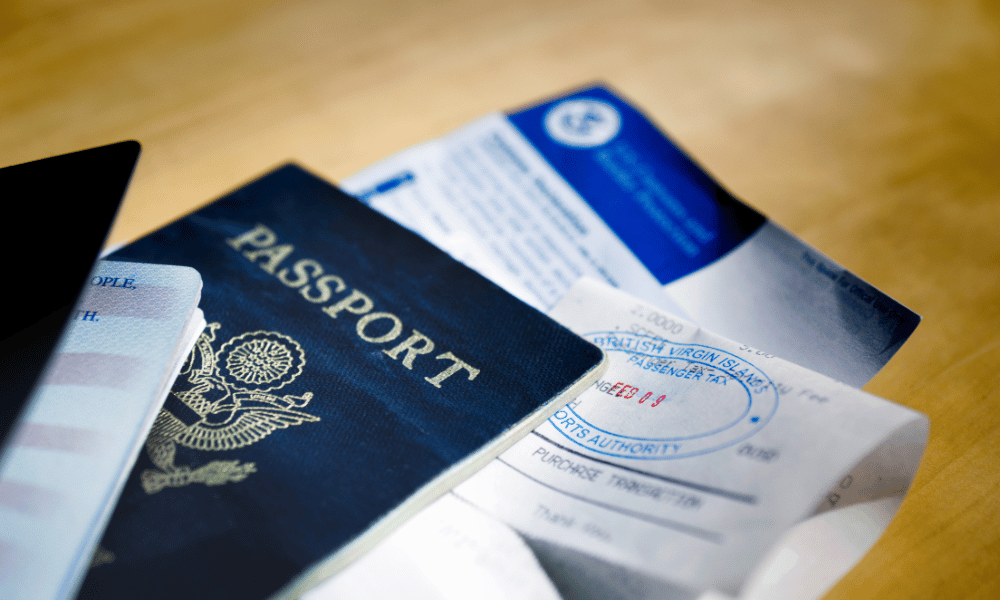
Application Process:
-
Online Application: Begin by filling out an online application form available on the official website of the Nepali Embassy. Ensure that you have all the necessary documents ready for upload.
-
Documentary Requirements: Prepare a set of documents including a valid passport with at least six months of validity, recent passport-sized photos, and proof of residence in Malaysia.
Visa Types and Fees:
-
Tourist Visa: Typically, Malaysians opt for a tourist visa which comes with different durations: 15, 30, and 90 days. Each has its respective visa fee, payable at the Embassy or upon arrival.
-
Visa Upon Arrival: Malaysians have the convenience of obtaining a visa upon arrival at Tribhuvan International Airport in Kathmandu. It's advisable to carry the exact change in USD to facilitate a smoother process. (Nepal Tourist Visa Online Form)
Visa Approval and Collection:
-
Embassy Submission: Submit the completed application along with the necessary documents at the Nepali Embassy in Malaysia.
-
Collection: Upon approval, collect the visa from the embassy or receive it upon arrival at the airport in Nepal.
Tibet Travel Permit:
-
Application: Once in Nepal, your tour operator will assist in obtaining the Tibet Travel Permit, essential for all foreign tourists traveling to Tibet.
-
Documentation: Provide the tour operator with necessary documents including a photocopy of the passport and the Nepali visa.
Alien Travel Permit and Military Permit:
-
Obtaining Permits: Additionally, pilgrims will need to secure the Alien Travel Permit and the Military Permit, which are generally facilitated by the tour operator managing the Yatra.
-
Region-Specific Permits: Depending on the specific regions covered during the Yatra, there may be additional permits required, which your tour operator will guide you through.
Process through Tour Operators:
-
Coordination with Chinese Authorities: The tour operators coordinate closely with the Chinese authorities to secure all necessary permits, ensuring a seamless journey through the various administrative regions en route to Mount Kailash and Lake Mansarovar.
-
Group Travel: It's essential to note that independent travel is not allowed in Tibet, and pilgrims must be part of an organized group facilitated by a recognized tour operator.
Getting a visa and permission is the first step on the Kailash Mansarovar Yatra, which is a spiritual journey. With a clear understanding of how the process works and the help of a reputable tour company, pilgrims can focus on getting their bodies and minds ready for the trip that will change their lives.
Physical and Mental Preparation
The Kailash Mansarovar Yatra is not only a journey, but also a test of how strong you are both physically and mentally. Here, we cover the most important ways to prepare your body and mind for a safe and enjoyable journey.
Cardiovascular Training:
-
Routine: Incorporate regular cardiovascular exercises such as jogging, brisk walking, and cycling in your routine, ideally starting at least 3-4 months before the Yatra.
-
Altitude Training: If possible, train in areas with higher altitudes to accustom your body to the conditions you will face during the Yatra.
Strength Training:
-
Core and Leg Strength: Focus on building core and leg strength through exercises like squats, lunges, and planks.
-
Backpack Training: Get used to walking with a backpack that has a weight similar to what you plan to carry during the Yatra.
Flexibility and Balance:
-
Yoga: Engage in yoga to improve flexibility and balance, which will aid in negotiating uneven terrains.
-
Breathing Exercises: Practice breathing exercises to enhance lung capacity, which can be beneficial at higher altitudes.
Research and Knowledge:
-
Understanding the Journey: Educate yourself about the pilgrimage's various aspects, including the terrain, altitude, and potential challenges, to mentally prepare for the journey.
-
Cultural Sensitization: Learn about the cultural and spiritual significance of the places you will visit, enhancing the depth of your experience.
Meditation and Mindfulness:
-
Meditation: Incorporate meditation in your daily routine to cultivate mental peace and resilience.
-
Mindfulness: Practice mindfulness to stay grounded and fully absorb the experiences during the Yatra.
Developing a Positive Mindset:
-
Positive Attitude: Cultivate a positive mindset, focusing on the spiritual growth and personal transformation the journey promises.
-
Emotional Preparedness: Prepare emotionally to handle the physical exertions with patience and perseverance.
Community Engagement:
-
Connecting with Fellow Pilgrims: Engage with communities or groups who have experienced the Yatra to gain insights and advice.
-
Group Discussions: Participate in group discussions and preparatory sessions organized by tour operators to foster a sense of community and shared purpose.
The Kailash Mansarovar Yatra is a test of both your mental as well as physical power. Preparing for this spiritual journey in a way that includes both physical training and mental preparedness can make you much more ready for it. Remember that this trip is not a race, but a journey of emotional and spiritual growth, where the journey itself is just as important as the goal.
Packing Essentials
One important part of getting ready for the Kailash Mansarovar Yatra is making sure you have everything you need packed. This includes clothes that are suitable for the weather, the right paperwork, and a well-equipped medical kit, among other things. Here is a list of the most important things you should bring on a journey.
Layered Clothing:
-
Thermal Base Layer: Carry thermal wear to keep you warm in the cold mountainous region.
-
Insulating Layer: Include fleece jackets or woolen sweaters to retain heat.
-
Outer Layer: Have a waterproof and windproof jacket to protect against rain and wind.
Accessories:
-
Headgear: Carry woolen caps or hats to protect against cold and sun.
-
Gloves: Insulated gloves are essential to protect hands from cold.
-
Scarves: Scarves or neck gaiters to protect the neck region.
Footwear:
-
Trekking Boots: Invest in a pair of good quality waterproof trekking boots.
-
Socks: Bring several pairs of thermal and moisture-wicking socks to keep feet warm and dry.
Passport and Visa:
-
Original Passport: Ensure your passport is valid for at least six months beyond your date of entry.
-
Nepali Visa: Carry the Nepali visa obtained from the Nepali embassy or upon arrival in Kathmandu.
Permits:
-
Tibet Travel Permit: Have a copy of the Tibet Travel Permit, facilitated by your tour operator.
-
Other Permits: Carry copies of the Alien Travel Permit and Military Permit, obtained through the tour operator.
Personal Identification:
-
Photocopies: Have photocopies of your passport, visa, and other ID proofs in case of loss or theft.
-
Photographs: Carry extra passport-sized photographs for various permit applications.
Medical Kit:
-
Prescription Medications: Carry any prescription medications in sufficient quantities.
-
Altitude Sickness Medication: Include medications for altitude sickness, as recommended by a healthcare provider.
-
First-Aid Kit: Pack a basic first-aid kit including band-aids, antiseptic cream, and pain relievers.
Personal Hygiene:
-
Sanitizers and Wet Wipes: As water may be scarce, carry hand sanitizers and wet wipes for personal hygiene.
-
Toiletries: Bring travel-sized toiletries including toothpaste, shampoo, and soap.
Other Essentials:
-
Sunglasses and Sunscreen: Protect yourself from the harsh sun with good quality sunglasses and sunscreen.
-
Water Bottle and Purification Tablets: Have a reusable water bottle and water purification tablets to ensure safe drinking water.
-
Snacks: Carry high-energy snacks like nuts and dried fruits to keep energy levels up during the trek.
The key component of having a good and comfortable Yatra is packing the right things. Every item in your bag is important, from clothes that are appropriate for the weather to necessary paperwork and a well-stocked emergency kit. Make sure to double-check your packing list and ask your tour company for any specific suggestions. This will make sure that your journey is well-planned and enjoyable.
Kailash Mansarovar Yatra by Drive
|
Day 01 |
Kathmandu Arrival. |
|
Day 02 |
Kathmandu Sightseeing. (Tibet visa application/takes 4 days) |
|
Day 03 |
Kathmandu Sightseeing. |
|
Day 04 |
Kathmandu Sightseeing. |
|
Day 05 |
Kathmandu Sightseeing and Packing. |
|
Day 06 |
Kathmandu to Timure/Rasuwa Gadhi. |
|
Day 07 |
Timure/Rasuwa Gadhi to Kyirong. (Tibet Entry) |
|
Day 08 |
Kyirong to Saga. |
|
Day 09 |
Saga to Lake Mansarovar. |
|
Day 10 |
Lake Mansarovar to Darchen. |
|
Day 11 |
Darchen to Dirapuk. (Yatra Day 1, 12 KM) |
|
Day 12 |
Dirapuk to Zuthulphuk. (Yatra Day 2, 22 KM) |
|
Day 13 |
Zuthulphuk to Saga. (Yatra Day 3, 8 KM) |
|
Day 14 |
Saga to Kyirong. |
|
Day 15 |
Kyirong to Kathmandu. |
|
Day 16 |
Departure. |
Kailash Mansarovar Yatra by Drive Dates
|
Month |
Starting Date |
|
May 2024 |
5, 12, 19, 26 |
|
June 2024 |
2, 9, 16, 23 |
|
July 2024 |
7, 14, 21, 28 |
|
August 2024 |
4, 11, 18, 25 |
|
September 2024 |
1, 8, 15 |
Kailash Mansarovar Yatra by Drive Cost
|
Group Size |
Deluxe Package (3 Star Hotel) |
Luxury Package (5 Star Hotel) |
|
4 People |
USD 3000 Per Person |
USD 3500 Per Person |
|
6 People |
USD 2900 Per Person |
USD 3400 Per Person |
|
10 People |
USD 2700 Per Person |
USD 3200 Per Person |
|
14 People |
USD 2600 Per Person |
USD 3100 Per Person |
|
20 People |
USD 2500 Per Person |
USD 3000 Per Person |
Read More : Kailash Mansarovar Yatra by Drive via Kyirong
Kailash Mansarovar Yatra by Helicopter
|
Day 01 |
Kathmandu Arrival. |
|
Day 02 |
Kathmandu Sightseeing. (Tibet visa application/takes 4 days) |
|
Day 03 |
Kathmandu Sightseeing. |
|
Day 04 |
Kathmandu Sightseeing. |
|
Day 05 |
Fly to Nepalgunj. |
|
Day 06 |
Nepalgunj to Simikot. |
|
Day 07 |
Simikot - Hilsa - Taklakot. |
|
Day 08 |
Rest Day for acclimatization in Taklakot. |
|
Day 09 |
Taklakot to Lake Mansarovar. (4550m) |
|
Day 10 |
Drive to Yama Dwara, Trek to Deruphuk. (4909m) (12 KM) |
|
Day 11 |
Trek to Zuthulphuk. (4760m) (22 KM) |
|
Day 12 |
Zuthulphuk to Hilsa or Simikot. (8 KM) |
|
Day 13 |
Hilsa to Simikot, fly to Nepalgunj and fly back to Kathmandu. |
|
Day 14 |
Departure. |
Kailash Mansarovar Yatra by Drive Dates
|
Month |
Starting Date |
|
May 2024 |
5, 19, 26 |
|
June 2024 |
29, 16, 23 |
|
July 2024 |
7, 21, 28 |
|
August 2024 |
11, 18, 25 |
|
September 2024 |
8, 15 |
Kailash Mansarovar Yatra by Helicopter Cost
|
Group Size |
Deluxe Package (3 Star Hotel) |
Luxury Package (5 Star Hotel) |
|
4 People |
USD 4200 Per Person |
USD 4800 Per Person |
|
6 People |
USD 4100 Per Person |
USD 4700 Per Person |
|
10 People |
USD 3900 Per Person |
USD 4500 Per Person |
|
14 People |
USD 3800 Per Person |
USD 4400 Per Person |
|
20 People |
USD 3700 Per Person |
USD 4300 Per Person |
Read More : Kailash Mansarovar Yatra by Helicopter via Hilsa
Arrival in Nepal
Your Kailash Mansarovar Yatra starts shortly after you arrive in Kathmandu, Nepal, which is a place full of life and history. In this part, we describe the initial feelings that come to mind when the plane lands, as well as the short but energizing tour and rest period that follows.
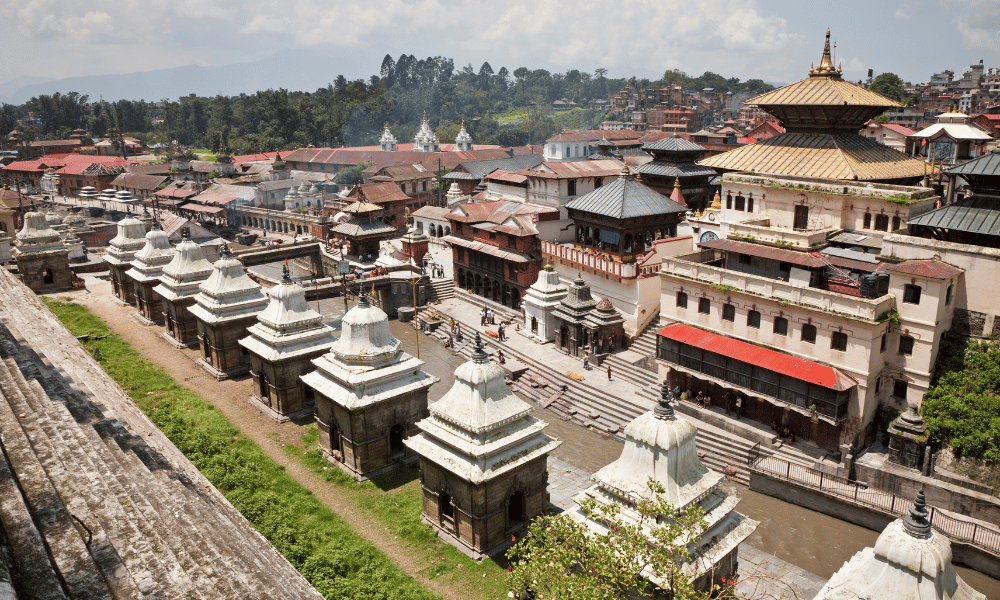
The Lively Atmosphere:
-
Airport Buzz: Tribhuvan International Airport, though small, is bustling with a medley of tourists, pilgrims, and adventurers, all eager to explore the myriad attractions Nepal offers.
-
Cultural Tapestry: Right from the airport, you would be greeted by the vibrant cultural tapestry of Nepal, characterized by traditional Nepali architecture and warm smiles of the locals.
Transition to the Spiritual Realm:
-
Spiritual Energy: As you step out of the airport, the spiritual energy of Kathmandu is palpable, with chants, prayer flags fluttering in the wind, and the distant view of the surrounding hills fostering a serene atmosphere.
-
Historical Backdrop: The city, steeped in history, provides a glimpse into a rich past through its traditional structures and heritage sites that dot the cityscape.
Sightseeing in Kathmandu:
-
Heritage Sites: Depending on your arrival time, a brief sightseeing tour can be arranged to visit some of the UNESCO World Heritage Sites such as Pashupatinath Temple, Boudhanath Stupa, and Swayambhunath Stupa, each echoing tales of spiritual awakening and ancient traditions.
-
Local Markets: If time allows, a stroll through the local markets offers a kaleidoscope of colors, aromas, and textures, where you can witness the daily lives of the locals and perhaps pick up some souvenirs.
Rest and Acclimatization:
-
Hotel Check-in: Following the sightseeing, you would be escorted to your hotel, where you can rest and rejuvenate before the Yatra begins.
-
Rest and Recuperate: Given the physically demanding nature of the Yatra, it is vital to have sufficient rest. Utilize this time to relax, meditate, and prepare yourself mentally for the journey ahead.
-
Pre-Yatra Briefing: In the evening, your tour operator might organize a briefing session to provide details about the Yatra, including the itinerary, weather conditions, and essential tips for a successful pilgrimage.
Once you get to Kathmandu, you will start an exciting spiritual journey. From the city's rich cultural background to its peaceful spiritual atmosphere, Kathmandu is a gentle introduction to the life-changing events that are still to come. The Kailash Mansarovar Yatra is a special trek that promises not only spiritual awakening but also a journey through Nepal's rich cultural tapestry. The Kailash Mansarovar Yatra is a combination of short sightseeing trips along with plenty of rest.
The Journey to Nepal-China Border
As you get ready to leave the busy city of Kathmandu, the next part of your trip will take you on an exciting path to the border between Nepal and China. This part of the trip not only has breathtaking views, but also gives you an opportunity to stop at a few interesting places along the way.
Route Details:
-
Kathmandu to Rasuwagadhi: The journey typically starts with a drive from Kathmandu to Rasuwagadhi, the border town between Nepal and China. The journey spans approximately 160 kilometers, offering stunning views of the Nepalese countryside.
-
Rugged Terrains: Be prepared for a journey through winding roads and rugged terrains, with the landscape gradually transitioning from lush greenery to more barren, mountainous vistas.
Crossing the Border:
-
Immigration Procedures: Upon reaching Rasuwagadhi, you will undergo immigration procedures facilitated by your tour operator.
-
Entering Tibet: After completing the necessary formalities, you will cross the Friendship Bridge to enter Kyirong in Tibet, marking the beginning of your Tibetan leg of the journey.
Acclimatization:
-
Kyirong Stay: It's often recommended to stay overnight in Kyirong to acclimatize to the higher altitudes, preparing your body for the further journey towards Kailash Mansarovar.
Trishuli River:
-
Picturesque Views: En route to Rasuwagadhi, you will be treated to splendid views of the Trishuli River, a prominent river flowing through the region with its swirling waters and surrounding greenery.
-
Rafting Opportunity: For the adventure enthusiasts, there might be an opportunity to indulge in white-water rafting, though this would depend on the itinerary set by your tour operator.
Nuwakot:
-
Historical Significance: If time permits, a detour to Nuwakot can be arranged, a place steeped in history and known for its ancient palaces and fortresses that reflect Nepal’s rich heritage.
-
Nuwakot Palace: A visit to the Seven Story Palace, also known as the Nuwakot Palace, can offer a glimpse into the grandeur of Nepal's past.
Langtang National Park:
-
Flora and Fauna: While on the route, you will pass by the peripheries of Langtang National Park, home to a diverse range of flora and fauna, including the elusive red panda.
-
Stunning Landscapes: Capture the stunning landscapes that offer a prelude to the picturesque vistas that await in Tibet.
The trip from Kathmandu to the border between Nepal and China is a taste of the exciting adventure that is soon to follow. This part of the trip not only has beautiful views, but also gives you a taste of Nepal's history and natural beauty. As you travel this path, soak up the experiences, as they will add to the rich tapestry of memories that the Kailash Mansarovar Yatra promises to be.
Crossing into Tibet
A big part of your Kailash Mansarovar Yatra is getting from Nepal into Tibet. The change from the green landscapes of Nepal to the unique landscapes of the Tibetan plateau is nothing short of magical. Here, we explain what you need to do at the border and what to expect when you enter the amazing land of Tibet.
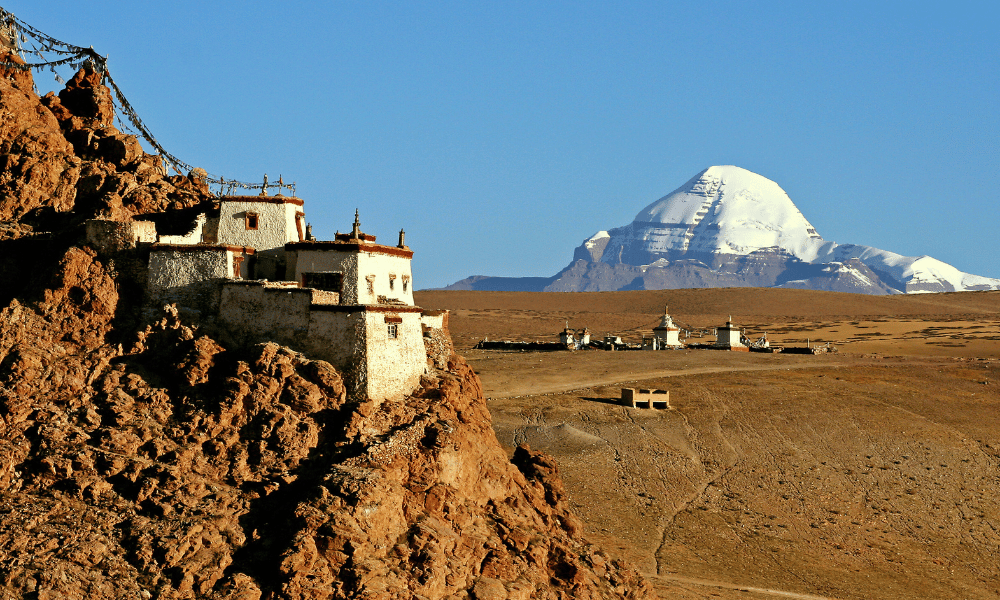
Documentation and Verification:
-
Identity Verification: Your identification documents will be thoroughly checked by the Chinese authorities at the border. Ensure to have your passport, Tibet Travel Permit, and other necessary permits handy.
-
Luggage Screening: Be prepared for a luggage screening process, where your belongings might be checked for restricted items.
Customs Declaration:
-
Customs Form: You will be required to fill a customs declaration form where you need to declare any items as per the regulations outlined by the Chinese government.
-
Currency Regulation: Be aware of the currency regulations, and declare if you are carrying a substantial amount of currency, as per the guidelines.
Health and Quarantine Checks:
-
Health Screening: Given the ongoing global health concerns, there might be health screenings to ensure the well-being of all travelers.
-
Quarantine Regulations: Stay informed about any quarantine regulations that might be in place, and comply accordingly to ensure a smooth transition into Tibet.
Changing Landscape:
-
From Green to Barren: As you cross into Tibet, you will notice a significant shift in the landscape, transitioning from lush greenery to the barren, yet stunningly beautiful Tibetan plateau.
-
Mountain Vistas: Be greeted by expansive vistas featuring towering mountains adorned with snow caps, portraying a pristine and untouched beauty.
Cultural Shift:
-
Architectural Transition: You will observe a transition in architectural styles, with Tibetan structures reflecting a strong Buddhist influence, characterized by vibrant colors and intricate designs.
-
Spiritual Atmosphere: Feel the deep spiritual energy that pervades Tibet, with prayer flags fluttering in the wind, chanting monks, and the serenity that envelops the region.
The Serene Kyirong Valley:
-
Natural Beauty: Your first stop is likely to be Kyirong, a picturesque valley that offers a tranquil retreat amidst the natural beauty of the Tibetan plateau.
-
Acclimatization: Utilize this time to acclimatize to the higher altitudes, taking gentle walks to explore the surrounding areas and soaking in the tranquil atmosphere.
Crossing into Tibet is more than just a change in location; it's a journey into a land full of belief and natural beauty that can't be found anywhere else. As you go through the formalities at the border and step onto the Tibetan plateau, prepare yourself to be mesmerized by a landscape that will stir your soul and give you experiences that are deeply spiritual and deeply changing. It's the start of a journey that offers not only breathtaking views but also spiritual enlightenment in the Himalayas.
Exploring Mansarovar
The Kailash Mansarovar Yatra isn't complete until you've seen the holiness and mesmerizing beauty of Lake Mansarovar, a place filled with faith and natural beauty. In this part, we learn more about the beautiful Lake Mansarovar and the ceremonies and practices that pilgrims take part in to add a holy touch to their trip.
Location and Geography:
-
High Altitude Freshwater Lake: Situated at an altitude of 4,590 meters, Lake Mansarovar is one of the highest freshwater lakes in the world, nestled in the shadow of the majestic Mount Kailash.
-
Changing Hues: Witness the surreal phenomenon of changing hues of the lake, which seems to change colors from clear blue to emerald green, offering a picturesque backdrop for meditation and reflection.
Spiritual Significance:
-
Hindu Mythology: In Hindu mythology, it is believed to be the abode of Lord Shiva, and taking a dip in the lake is considered to cleanse sins accumulated over a lifetime.
-
Buddhist Beliefs: Buddhists believe that Queen Maya was transported here to conceive Lord Buddha, adding a significant spiritual dimension to the lake.
Flora and Fauna:
-
Bird Watching: The lake is a haven for bird enthusiasts, hosting a variety of migratory birds that visit the lake seasonally.
-
Wildlife: While exploring the surroundings, you might catch glimpses of wild animals native to the region, adding a touch of wilderness to the spiritual journey.
Ritual Bath:
-
Holy Dip: Pilgrims partake in the ritual of taking a holy dip in the lake, believed to purify the soul and bring spiritual rejuvenation.
-
Morning Prayers: Many choose to perform this ritual early in the morning, accompanied by prayers and hymns, creating a spiritual atmosphere that resonates with peace and sanctity.
Kora (Circumambulation):
-
Walking the Perimeter: Pilgrims engage in the practice of Kora, walking the perimeter of the lake, a ritual believed to bring good fortune and spiritual merit.
-
Prayer Wheels and Flags: During the Kora, pilgrims often spin prayer wheels and plant prayer flags, sending out prayers and positive vibrations into the universe.
Meditation and Yoga:
-
Meditative Retreat: The serene surroundings of Lake Mansarovar provide a perfect setting for meditation, allowing pilgrims to connect deeply with their inner selves.
-
Yoga Sessions: Many groups organize yoga sessions by the lake, combining physical well-being with spiritual enrichment, amidst the tranquil environment.
Exploring Lake Mansarovar is like walking into a heavenly painting, where nature and faith blend to create a calm and deep experience. As you participate in rites and take in the natural beauty of the lake, you begin a journey of spiritual awakening. Each event brings you closer to holy energy and inner peace, making the Kailash Mansarovar Yatra a pilgrimage full of memories and spiritual growth.
The Kailash Kora
One of the most important parts of the Kailash Mansarovar Yatra is the renowned Kailash Kora, a spiritual walk around the holy Mount Kailash. Here, we describe the details of the Kora, drawing in personal experiences and stories that make this part of the trip truly life-changing.
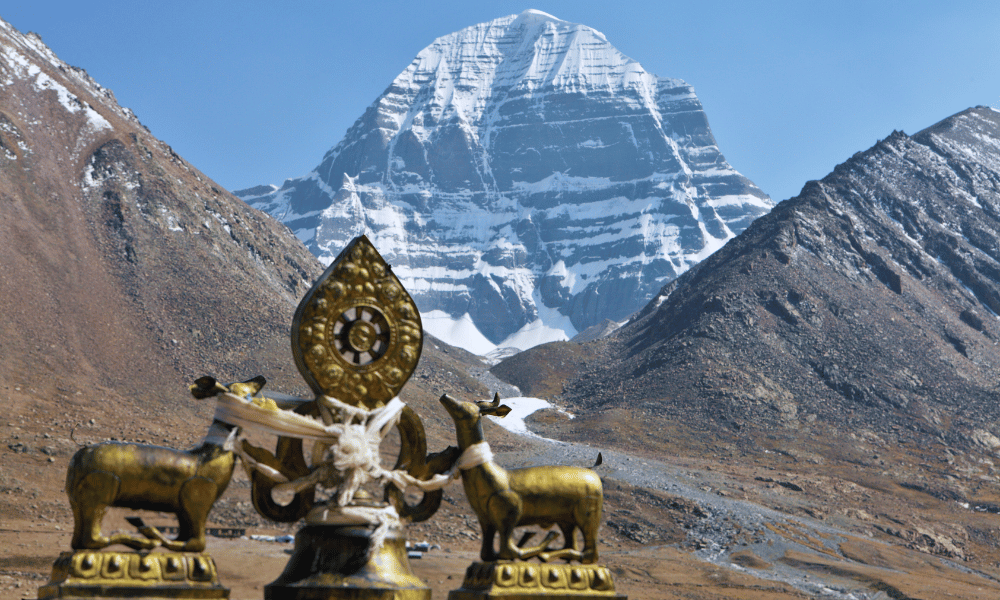
Route Overview:
-
Distance and Duration: The Kora spans approximately 52 kilometers, generally completed over a span of 3 days, leading pilgrims through a series of varied landscapes encompassing mountains, valleys, and numerous cultural sites.
-
Altitude and Terrain: It is a high-altitude trek with rugged and sometimes steep terrains. The journey starts at Darchen (4,575 meters) and reaches its highest point at Dolma La Pass (5,645 meters).
Significant Landmarks:
-
Tarboche (Yam Dwar): The starting point of the Kora, known as the gateway of the god of death, symbolizes leaving behind the material world and stepping into a spiritual journey.
-
Gauri Kund: Also known as the Lake of Compassion, this site is a spiritual halt where pilgrims pay their respects and make offerings.
Cultural and Spiritual Significance:
-
Meeting of Faiths: The Kora is not just significant in Hinduism but also in Buddhism, Jainism, and Bon religion, thus it becomes a meeting point of various faiths, showcasing religious harmony.
-
Path to Enlightenment: It is believed that completing the Kora helps in attaining Moksha (liberation) and brings the pilgrims closer to the divine.
Personal Challenges:
-
Physical Endurance: Pilgrims share tales of physical endurance, pushing their limits to complete the Kora, finding an inner strength they didn't know existed.
-
Mental Resilience: Many narrate experiences of mental resilience, where the journey becomes a meditation, teaching them perseverance and patience.
Spiritual Encounters:
-
Visionary Experiences: Some pilgrims share visionary experiences, where they feel the presence of the divine or have profound spiritual revelations during the journey.
-
Dreams and Signs: Many recount dreams and signs encountered during the Kora, which they interpret as messages or blessings from the divine.
Community and Bonding:
-
Shared Experiences: The Kora fosters a sense of community, where people from diverse backgrounds come together, sharing experiences, tales, and forming bonds that last a lifetime.
-
Help and Compassion: Stories abound of pilgrims helping each other, showcasing acts of compassion and unity, embodying the spirit of the pilgrimage.
The Kailash Kora is not just a journey; it's a path that takes you through beautiful scenery and deep spiritual experiences. It shows how strong people can be, how spiritual truths can be revealed, and how shared events can bring people together. As pilgrims tell their personal stories and tales, it creates a rich tapestry of human effort, spiritual pursuit, and the search for a greater link with the holy. This makes the Kailash Kora a life-changing experience that is imprinted in the hearts of those who make this sacred trip.
Cultural Interactions
The Kailash Mansarovar Yatra is not only a spiritual journey, but also a rich cultural one. Meeting locals and learning about real Tibetan culture are features that make the trip even better. Let's look deeper into how these different cultures communicate.
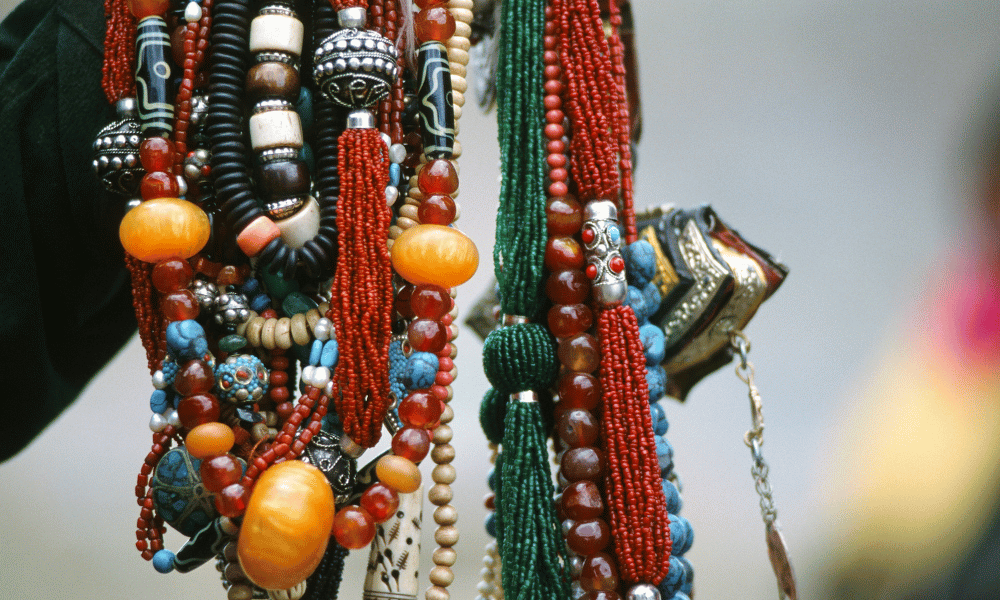
Language and Communication:
-
Language Barrier and Gestures: While the language barrier can be a challenge, many pilgrims find that communication transcends words, happening through smiles, gestures, and the universal language of kindness.
-
Guides and Interpreters: Leveraging local guides and interpreters can significantly enhance your interactions with the locals, helping you understand their customs, stories, and way of life more intimately.
Local Hospitality:
-
Homestays and Guesthouses: Choosing to stay in local homestays or guesthouses can offer a firsthand experience of the warm and welcoming nature of the Tibetan people.
-
Culinary Experiences: Sharing a meal with the locals can be a delightful experience, offering insights into their culinary traditions and tastes.
Learning from the Community:
-
Traditional Crafts and Arts: Engage with the locals to learn about their traditional crafts, arts, and practices, which are often deeply entwined with their spiritual beliefs.
-
Stories and Folklores: The locals are a treasure trove of stories and folklores, sharing tales that add depth to the places you visit and offering glimpses into their rich cultural heritage.
Music and Dance:
-
Traditional Performances: Witnessing traditional Tibetan performances can be an exhilarating experience, offering a window into their vibrant culture characterized by colorful attire and melodious tunes.
-
Participation in Local Festivities: If your journey coincides with local festivals, do participate in the celebrations, which are often marked by music, dance, and other cultural performances.
Religious Practices and Ceremonies:
-
Monastery Visits: A visit to the local monasteries will give you a deeper understanding of Tibetan Buddhism, marked by rituals, ceremonies, and the tranquil presence of monks.
-
Prayer Rituals: Engage in prayer rituals with the locals, be it turning the prayer wheels or lighting a butter lamp, these experiences connect you deeply with the spiritual essence of Tibet.
Art and Architecture:
-
Sacred Art: Discover the intricate details of Tibetan sacred art, which is reflected in their Thangka paintings, statues, and other artistic expressions.
-
Architectural Marvels: The region is home to architectural marvels, characterized by unique Tibetan designs, where every structure tells a story of its historical and cultural significance.
The Kailash Mansarovar Yatra is built around cultural exchanges. Pilgrims not only go on a spiritual trip, but they also immerse themselves in the rich cultural tapestry of the area. By talking to the locals and experiencing the rich culture of Tibet, visitors learn stories, traditions, and customs that add depth to their trip and help them grow spiritually and culturally.
Challenges Faced
The Kailash Mansarovar Yatra is a deep and meaningful journey, but it also has its own obstacles that travelers must overcome. From altitude sickness to language barriers, we talk in length about these problems to help people who want to go on the pilgrimage know what to expect.
Acclimatization:
-
Rapid Altitude Gain: Given the rapid altitude gain during the journey, acclimatization becomes critical. Pilgrims need to spend adequate time at different elevations to allow their bodies to adjust to the reduced oxygen levels.
-
Symptoms and Remedies: Understanding the symptoms of altitude sickness and knowing the remedies can be a lifesaver. Symptoms include headaches, dizziness, and shortness of breath. Remedies might involve descent to a lower altitude, hydration, and rest.
Physical Fitness:
-
Fitness Regime: Before embarking on the Yatra, adhering to a fitness regime that focuses on building stamina and physical endurance can be beneficial in navigating the strenuous segments of the journey.
-
Medical Check-ups: Regular medical check-ups in the lead-up to the Yatra are recommended to ensure that pilgrims are physically fit and capable of undertaking the journey.
Dietary Restrictions:
-
Limited Cuisine Options: Due to the remote locations visited during the Yatra, cuisine options might be limited, and pilgrims might face challenges in finding food that suits their dietary preferences or restrictions.
-
Carrying Necessary Supplies: Pilgrims are advised to carry necessary food supplies that cater to their dietary needs to avoid health issues due to sudden changes in diet.
Communication Gaps:
-
Local Language: The local language in Tibet is Tibetan, and not many locals might be proficient in English or other languages, which can lead to communication gaps.
-
Learning Basic Phrases: Learning basic phrases in the Tibetan language can be beneficial in facilitating smoother interactions with the locals.
Guides and Translators:
-
Hiring Local Guides: Hiring local guides who are proficient in both English and Tibetan can help bridge the language gap and enhance the overall experience of the Yatra.
-
Translation Apps: Utilizing translation apps can be a handy tool in navigating language barriers, helping pilgrims communicate more effectively with the locals.
Cultural Sensitivity:
-
Understanding Cultural Nuances: Understanding the cultural nuances of communication in Tibet can help in avoiding misunderstandings and fostering positive interactions with the locals.
-
Patience and Respect: Exercising patience and showing respect towards the locals can go a long way in overcoming language barriers and fostering a sense of community and understanding.
The Kailash Mansarovar Yatra is a spiritual and cultural event that only happens once in a lifetime. However, it is not easy. Being ready to face and get past these problems, like health problems caused by high altitudes or language challenges, can help make sure that a pilgrimage is good and full of learning. Pilgrims can handle these difficulties well by taking the right steps, asking for help, and going into the trip with an open mind and willingness to change. This will make their Yatra a fulfilling and memorable experience.
In The End
As the Kailash Mansarovar Yatra comes to an end, people are left with a treasure chest of memories and experiences that touch them deeply on a spiritual and personal level. In this part, we think about how the trip leads to deep spiritual and personal growth and how the stunning beauty of the landscapes leaves permanent marks on the pilgrims' minds.
Inner Transformation:
-
A Journey Inward: The Yatra often turns out to be a journey inward, a time of introspection where pilgrims find themselves connecting with their inner selves on a deeper level.
-
Healing and Purification: Many recount experiences of healing and purification, where the journey helps them let go of past burdens and emerge with a renewed spirit.
Enhanced Wisdom and Understanding:
-
Spiritual Enlightenment: The pilgrimage provides an opportunity for gaining spiritual enlightenment, enhancing wisdom, and deepening understanding of the self and the universe.
-
Life Perspectives: Pilgrims often return with altered life perspectives, having gained insights into the ephemeral nature of life and the importance of spiritual growth.
Community and Relationships:
-
Bonding and Friendships: The journey fosters bonding and friendships, as pilgrims share experiences and support each other through the challenges.
-
Empathy and Compassion: Being part of a community of like-minded individuals cultivates empathy and compassion, enriching personal relationships and fostering unity.
Natural Splendor:
-
Pristine and Untouched: The landscapes encountered during the Yatra are pristine and untouched, offering a stark contrast to the bustling urban environments many are accustomed to.
-
Harmony with Nature: The journey offers an opportunity to be in harmony with nature, to appreciate its grandeur, and to find solace in its tranquillity.
Photographic Memories:
-
Visual Feasts: Every turn offers a visual feast, from the awe-inspiring Mount Kailash to the serene Lake Mansarovar, providing ample opportunities for photography and creating lifelong memories.
-
Artistic Inspirations: The beautiful landscapes often serve as artistic inspirations, encouraging pilgrims to engage in artistic pursuits such as painting, writing, or poetry, capturing the beauty they witnessed in various forms.
A Gateway to the Divine:
-
Sacred Spaces: The landscapes are not just naturally beautiful but also spiritually potent, being considered as sacred spaces that facilitate a closer connection with the divine.
-
Cosmic Energy: Many pilgrims describe feeling a unique kind of cosmic energy in these landscapes, which rejuvenates their spirit and enhances their spiritual connection.
In hindsight, the Kailash Mansarovar Yatra is not just a trek, but also a journey of self-discovery and growth. It gives tourists a chance to think about their spiritual path, grow as individuals. and get lost in the beauty of scenery that look like they could be from another planet. As they walk through holy places, see how beautiful nature is, and connect with other travelers, they find that their souls are enriched and their hearts are full of thanks and respect. It is a trip that leaves a mark that lasts forever and encourages people to use the lessons they learn and the beauty they see in their everyday lives. This helps them feel closer to themselves, their community, and the divine.
Travel Tips
The Kailash Mansarovar Yatra is a huge event. To make sure the trip goes smoothly and is worthwhile, here are some tips on the best time to visit and important resources and connections that may be helpful.
Seasonal Considerations:
-
Summer Months (May to September): The summer months, specifically from May to September, are considered the best time to undertake the Yatra. During this period, the weather is relatively warm and the paths are clear, making the journey somewhat less strenuous.
-
Avoiding Monsoon and Winter: It is advisable to avoid the monsoon season (July to August) as the region experiences heavy rains and landslides. Similarly, the winter months can be extremely harsh with snow-blocked paths and freezing temperatures.
Festival Periods:
-
Saga Dawa Festival: If possible, planning your trip to coincide with the Saga Dawa festival can be a special experience, as it is one of the most celebrated festivals in the region marking the enlightenment and parinirvana of Buddha.
-
Booking in Advance: Due to the popularity of the Yatra, especially during festivals and favorable months, ensure to book your trip well in advance to secure a spot.
Astrological Considerations:
-
Auspicious Dates: You might also consider consulting a calendar of auspicious dates based on the Tibetan lunar calendar, as many pilgrims prefer to undertake the Yatra on dates considered to be spiritually significant.
Planning a trip to Kailash Mansarovar isn't easy, and having the right tools and knowledge can make a big difference in how good your journey is. By picking the right time to travel and making a list of important contacts and resources, you can make sure that your trip is not only emotionally fulfilling, but also safe and well-planned. Here's wishing that your trip to one of the holiest places on Earth is life-changing and educational.
Frequently Asked Questions
The Kailash Mansarovar Yatra, which starts in Malaysia through Nepal, is a spiritual and beautiful journey. But you might have a few questions before you start on this mental path. We've put together a list of the most commonly asked questions to help you plan your journey well.
What is the best time to undertake the Kailash Mansarovar Yatra from Malaysia via Nepal?
Answer: The ideal time for the Yatra is between May and September when the weather is relatively mild and the paths are clear. It is advisable to avoid the monsoon season (July to August) due to heavy rains and potential landslides, as well as the winter months due to extreme cold and snow-blocked paths.
How do I obtain the necessary visas and permits for the Yatra?
Answer: To undertake the Yatra, you would need to obtain a Nepali visa, which can be applied for at the Nepalese Embassy in Malaysia or on arrival in Kathmandu. Additionally, you will need to secure a special permit for the Kailash Mansarovar region, which is usually arranged by the travel agency organizing the Yatra.
What are the essential items to pack for the Yatra?
Answer: Packing essentials include weather-appropriate clothing (including thermal wear and rainproof clothing), necessary documentation (including passport, visas, and permits), and a comprehensive medical kit. Personal essentials such as sunblock, sunglasses, and a sturdy pair of trekking boots are also recommended.
Can I undertake the Yatra if I have medical conditions?
Answer: The Yatra involves high-altitude trekking and can be physically demanding. It is recommended to consult with your healthcare provider to assess your physical fitness before planning the trip. Carry necessary medications and be prepared for the high-altitude conditions.
What cultural experiences can I expect on the route via Nepal?
Answer: The route via Nepal offers a rich cultural experience, with opportunities to explore the vibrant city of Kathmandu, visit historic sites, and interact with locals. Additionally, once in Tibet, you will have the chance to immerse yourself in Tibetan culture, experiencing their customs, traditions, and cuisine.
What kind of physical and mental preparation is required for the Yatra?
Answer: Physically, it is recommended to undertake a fitness regime that focuses on building stamina and endurance. Mentally, preparing oneself for the challenges of high-altitude trekking and being adaptable to changing conditions is crucial.
What are some challenges I might face during the Yatra?
Answer: Some common challenges include altitude sickness, physical exhaustion, and language barriers. However, with proper preparation and guidance, these challenges can be managed effectively.
Can I interact with the locals during the Yatra?
Answer: Yes, there will be opportunities to interact with the locals, both in Nepal and Tibet. Embrace these interactions as they offer a window into the rich cultural tapestry of the region.
What can I expect during the Kailash Kora?
Answer: The Kailash Kora is a three-day circumambulation of Mount Kailash, considered highly sacred in several religions. Pilgrims can expect a physically demanding trek complemented by awe-inspiring views and a profound spiritual experience.


